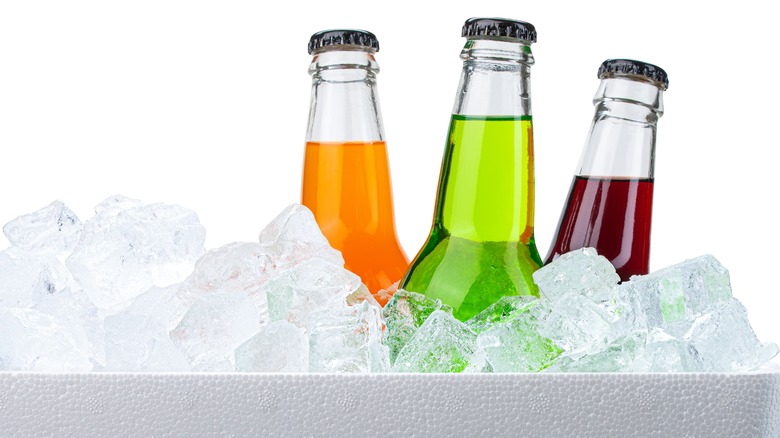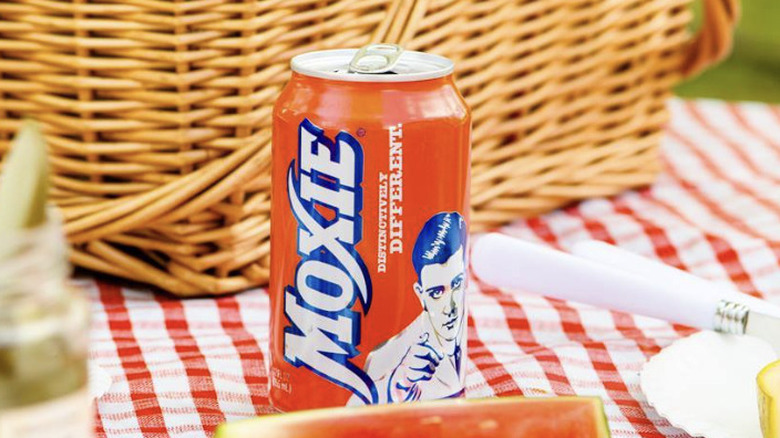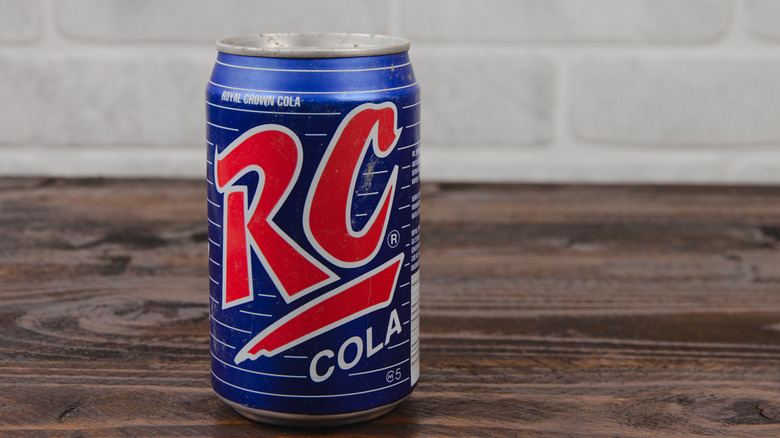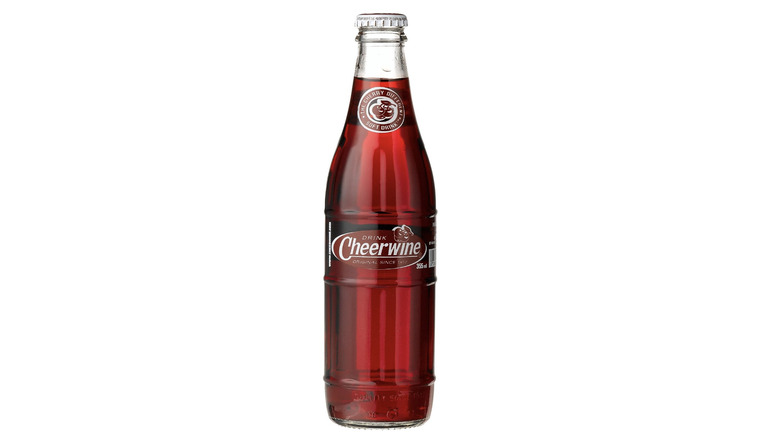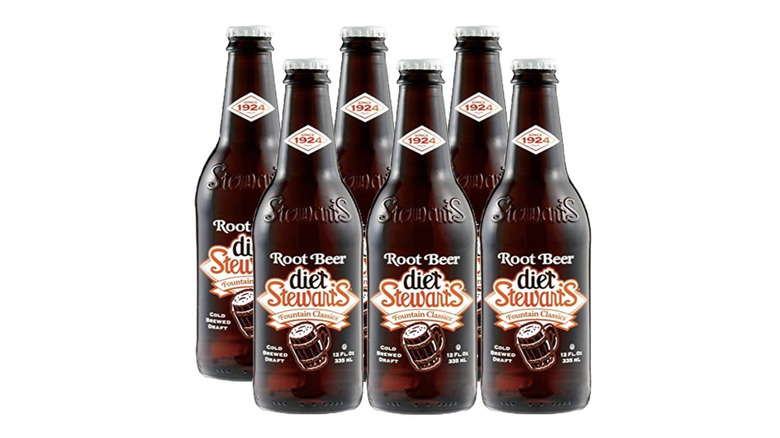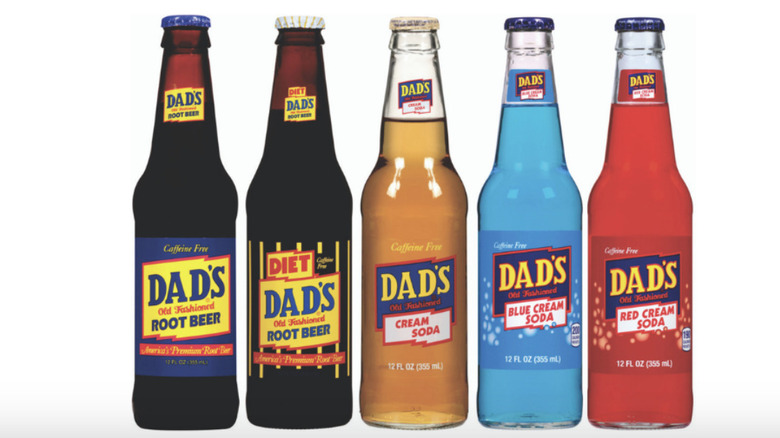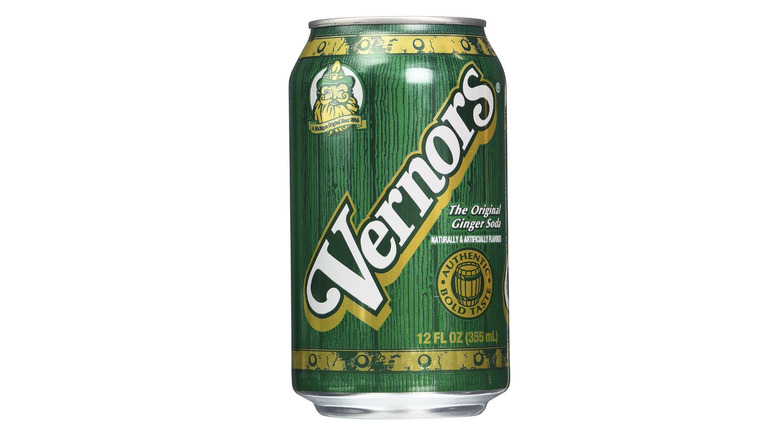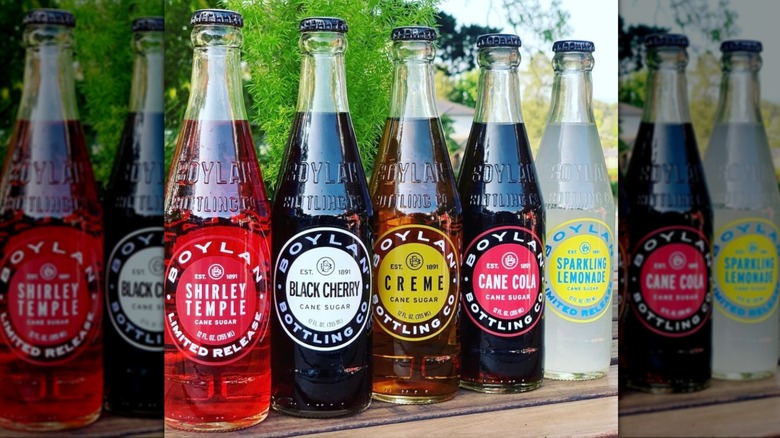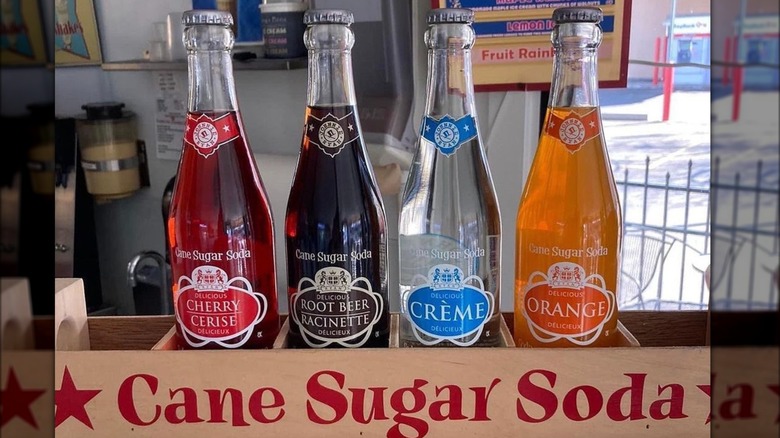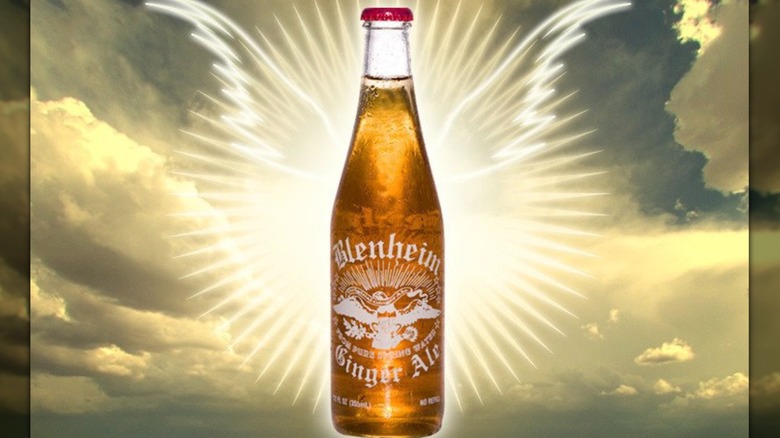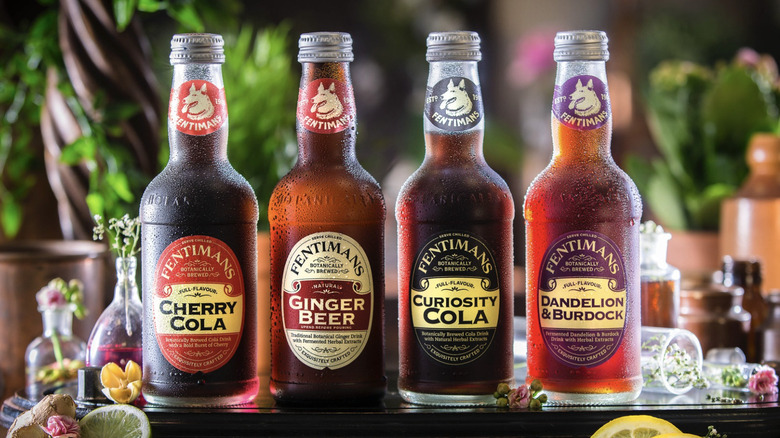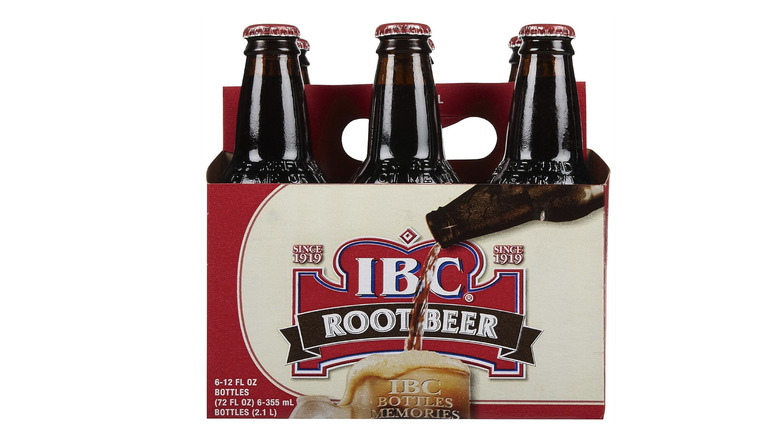Old Fashioned Soda Brands You Can Still Buy Today
We may receive a commission on purchases made from links.
While annual soda consumption in the U.S. has declined from 49.7 gallons per capita in 2000 to 43.1 gallons in 2022, we remain a nation of carbonated drink lovers (via IBIS World). The American love affair with fizzy beverages dates back to the 18th century when Schweppes started selling carbonated mineral water. It wasn't until the second part of the 19th century, however, that soda as we know it today started taking shape, with the first drink variations often marketed as medicinal tonics.
While some of the oldest soda brands, including Schweppes, Coca-Cola, and Pepsi, remain the world's most popular, there are plenty of lesser-known classic soft drinks with legions of devotees. These brands may not have the same global recognition as the industry giants, but they have managed to carve out their own niches and loyal customer bases. These old-school beverages offer a sense of nostalgia and a unique taste that appeals to consumers seeking something different from what the mainstream has on offer. Whether it's a connection to their hometowns, family traditions, or simply a preference for a distinct flavor, these retro sodas continue to thrive.
Ready for a fizzy blast from the past? Check out our list of old-fashioned soda brands you can still buy today.
Moxie
Moxie holds the title of being the first commercially distributed soft drink in the U.S. The fizzy drink burst onto the scene in 1876, a solid decade before anybody had even heard of Coca-Cola and 22 years before Pepsi-Cola entered the market. While Moxie was an initial success — at one stage it even managed to outdo Coca-Cola in the sales department — its popularity started to dwindle during the Great Depression. Nevertheless, the caramel-colored beverage can still be found on supermarket shelves and is even revered in some regions of the U.S. A case in point is Maine's annual Moxie Festival, which has been entertaining soda enthusiasts since 1982.
Moxie started its long career as a medicinal tonic. In fact, in its early years, it was marketed as Moxie Nerve Food, a cure-all concoction for a huge range of ailments. And the beverage tasted the part. Made from gentian root, which is also an ingredient in cocktail bitters, Moxie wasn't sweet like many of the pops we know and love today. Instead, the soda was herbal and somewhat bitter. Moxie transformed into a soft drink in 1884 when carbonated water was added to the mix. And the pop's flavor has stayed pretty much the same over time. The two notable exceptions were the replacement of sugar with high-fructose syrup and the removal of sassafras, which was banned by the FDA in the 1960s.
RC
In 1905, a pharmacist named Claud A. Hatcher revolutionized the soda industry by developing the very first RC soda. This pioneering creation was the Royal Crown Ginger Ale (today known as RC Refresher Ginger Ale), which made its debut at the Hatcher family's grocery store in Columbus, Georgia. The pop was so successful that it prompted Hatcher to establish the Union Bottling Works and introduce his second offering — a cherry-flavored drink called Chero-Cola.
The new kid on the block quickly outshined its older sibling, promoting the company to change its name to the Chero-Cola Company in 1912. By the time 1920 rolled around, Hatcher was supplying soda syrups to a whopping 700 bottling plants. Following a legal dispute with no other than Coca-Cola, which lay claim to the Cola trademark, RC was forced to shorten the name of its bestseller from Chero-Cola to Chero in 1923. To say that this wasn't good for business would be an understatement.
The company's journey took an unexpected turn after Hatcher's passing in 1933. The following year, the company's sales director, H.R. Mott, decided to revive Chero-Cola minus its cherry flavor as a soft drink called Royal Crown. The strategy worked, propelling the pop into the big leagues. In 1944, the court determined that the term "cola" wasn't the exclusive property of Coca-Cola, clearing the path for Royal Crown's evolution into Royal Crown Cola, or the iconic RC Cola we know today.
Cheerwine
Don't let its boozy name mislead you. Cheerwine is completely alcohol-free. Instead, its name is derived from the soft drink's deep burgundy color and cherry flavor. And if you haven't had the pleasure of trying this concoction yet, there's an explanation. While Cheerwine might be a staple in the southeast, it's not as readily available in other areas of the states.
Developed in 1917, Cheerwine is "the oldest continuing soft drink run by the same family," as the Cheerwine website proudly proclaims. Back in the day, the carbonated drink was the answer to a sugar shortage that hit the U.S. in the early 20th century. Amid rationing, L.D. Peeler, who was already producing Mint Cola at his Carolina Beverage Corporation, was determined to come up with a fresh soda flavor and a new method to infuse his beverage with sweetness. His answer came in the form of cherry flavoring, an ingredient that sweetened the soda without the need for quite as much sugar.
The strategy worked, with Cheerwine overtaking Mint Cola in sales by 1924. In fact, it did so well that Peeler ended up naming his company Cheerwine Bottling Co. Even today, the soda is renowned for its sweet taste, as attested to by culinary critic Alan Richman. The food writer once wrote in GQ that "Cheerwine is pretty much the sweetest soft drink ever made, and in my opinion the greatest accompaniment to barbecue ever produced."
Stewart's
This may come as a surprise to many, but Stewart's wasn't commercially bottled until 1990, which is remarkable considering that Stewart's root beer was invented in the early 20th century. During the intervening decades between its invention and commercial bottling, Stewart's gained popularity primarily through local soda fountains and a chain of Stewart's Drive-Ins. Since then, Stewart's has broadened its soda collection beyond the humble root beer and today offers a variety of soda flavors including grape, orange and cream, black cherry, cherries and cream, and key lime. More recently, the brand has even released alcoholic versions of its soft drinks called Stewart's Spiked.
Stewart's story begins in 1924 when Frank Stewart developed a root beer recipe to bolster his meager earnings as a school teacher. Initially selling his blend of 20 different herbs, roots, and berries at a root beer stand in his native Mansfield, Ohio, Stewart eventually ended up establishing Stewart's Drive-In franchises across the Midwest and Mid-Atlantic. Up to this day, one of the franchise's most iconic menu items is the root beer float with vanilla ice cream. There's even a National Stewart's Root Beer Day that takes place every 17th of June to celebrate the legacy of this iconic beverage.
Dad's
Whether you're savoring a root beer or indulging in a flavored cream soda, Dad's delivers both flavor and a touch of nostalgia. Crafted in the 1930s by business partners Barney Berns and Ely Klapman, Dad's Root Beer first took off in the Midwest. By the tail end of the 1940s, the beverage had solidified itself as one of the most popular root beers in the U.S., and by the 1950s, Dad's was bottled and distributed by a network of over 160 partners.
Dad's marketing was innovative for its time, being the first product to embrace the six-pack bottle packaging invented by the Atlanta Paper Company in the 1940s. The brand also used the familiar ethos of the family structure to appeal to consumers. More specifically, Dad's was sold in three bottle sizes: the half-gallon "Papa," the quart-sized "Mama," and the 12-ounce "Junior." The half-gallon bottle size was also a Dad's invention. The brand also led the way in innovative promotions, once rolling out an offer where customers who purchased a "Papa" bottle at the regular price could buy a "Mama" bottle for an extra penny.
Today, Dad's continues to craft root beer using its original blend of ingredients including licorice, wintergreen, and vanilla. Additionally, the company offers a diverse selection of cream sodas, including orange cream soda, blue cream soda, and red cream soda.
Vernors
Historian Keith Wunderlich once told The Detroit News, "It's hard to tell the story of someone who grew up in Detroit in the 1940s and '50s that doesn't somehow involve Vernors." For most raised in Michigan, Vernors ginger ale isn't just a beverage, but an integral part of the local heritage. Whether it's cooking with the soda, drinking it to settle an upset stomach, or even enjoying it as a part of an ice cream float, Vernors Ginger Ale continues to be interwoven with memories that evoke a connection to a bygone era.
According to one story, Vernors ginger ale was invented by a junior drug store clerk called James Vernor who left behind a concoction of ginger, vanilla, and spices in a wooden barrel while he served in the Civil War. After returning from the war in the mid-1860s, Vernor discovered that the mixture had transformed into a delicious beverage. While the story is intriguing, it's more likely that Vernor developed his ginger ale formula after the Civil War. However it first came to be, Vernors ginger ale could be purchased at a soda fountain at Vernor's Michigan pharmacy by 1866. Over the next few decades, the fizzy drink became so popular that in 1896 Vernor made the decision to shutter his pharmacy and open a bottling plant. The rest, as they say, is history.
Boylan
First concocted by New Jersey pharmacist William Boylan in 1891, the flagship Boylan soda, aptly named Boylan's Birch, was sold right out of a barrel that was transported around the area on a wagon. Made from the sap of the birch tree, the product was so successful that Boylan started bottling it as birch beer after the turn of the century. Despite its name, the beverage didn't contain any alcohol.
Today, Boylan still sells its alcohol-free Original Birch Beer, which the brand's website describes as "distinctively minty and sharp, with strong notes of sweet birch and wintergreen oil." There's also the Creamy Red Birch Beer, a smoother and creamier iteration of the original with a twist of vanilla, as well as a plethora of other soda options such as Cane Cola, creme soda, and ginger ale.
Best of all, Boylan is still served in very distinctive elongated glass bottles which haven't changed for decades. The vintage design comes complete with appealing embossed designs that harken back to the packaging of yesteryear. Last but not least, the circular retro labels complete the brand's timeless aesthetic.
Johnnie Ryan
The Johnnie Ryan soft drink company has been under the stewardship of the Janik family for three generations. And to this day, the Johnnie Ryan beverages continue to be sweetened with pure cane sugar, adhering to the tradition that was started back in the 1930s in Niagara Falls, New York. Still sold in old-fashioned glass bottles, Johnnie Ryan's extensive range of carbonated drinks includes root beer, ginger ale, creme soda, birch beer, and a range of flavored sodas. The company also sells flavored fountain syrups.
The birth of Johnnie Ryan was prompted by Coca-Cola's 1935 decision to discontinue its range of flavored soft drinks to focus solely on selling Coke. Recognizing an opportunity, the Janik brothers started producing their own line of flavored drinks. To promote their new product, the siblings sold it in 10-ounce bottles — instead of the standard 7 ounces — and called their venture the Extra Bottling Company. In 1942, the business was renamed the Johnnie Ryan Company by the grandfather of the present owners who took the reins of the business in 2001.
Blenheim Ginger Ale
Unlike many other soft drink brands that have diversified their portfolios, Blenheim Ginger Ale focuses squarely on what it does best — ginger ale. Although it might not enjoy widespread recognition throughout the entire U.S., Blenheim Ginger Ale has an enthusiastic fan base within the Carolinas, where it was first developed.
The origins of Blenheim Ginger Ale can be traced back to the latter stretch of the 19th century when Dr. C. R. May advised his patients to drink water from the Blenheim Artesian Mineral Springs in South Carolina. After many of his patients found fault with the water's robust flavor, the good doctor decided to spike the mineral water with Jamaican ginger to make it more palatable. The concoction became so popular that in 1903 Dr. May founded the Blenheim Bottling Company and embarked on the production of Original Extra Pale.
Even though Blenheim Ginger Ale has come up with a variety of products over the years, it's the fiery ginger ale that has been the key to its success. Staying true to its roots, the company continues to craft its original creation, the iconic #5 Not-as-Hot Gold Cap. For those in need of an extra kick, Blenheim Ginger Ale also produces the #3 Hot Red Cap, which "goes down as smoothly as a firecracker exploding in your throat" (via Blenheim Ginger Ale). There's also the #9 Diet White Cap for the calorie-conscious.
Fentimans
Fentimans soda comes with a fascinating backstory. In 1905, Englishman Thomas Fentiman was given a recipe for a botanically brewed ginger beer as collateral for a loan. When the borrowed funds weren't returned, Fentiman used the recipe to start producing Fentimans Ginger Beer, which he initially sold in distinctive ceramic jars. The business was a success and it wasn't long before Fentimans was running production facilities across the North East of England. While the plants shut down in the 1960s, Fentimans was revived in 1994 by Thomas' great-grandson, Eldon Robson. Today, the company logo features the image of Fearless, Thomas' faithful dog.
Unlike other soft drinks, Fentimans still uses the same botanical brewing method that was pioneered so long ago. The production process begins with the heating of ingredients in simmering water to unlock their distinct flavors. The liquid is then fermented with sugar and yeast for seven days and infused with essential oils and natural flavors. The end product is then mixed with water and beet sugar before progressing to the carbonation and pasteurization stage.
In an interview with the North East Times Magazine, Robson recently summed up what makes Fentimans stand out from the fizzy beverage pack. "We [...] are always looking at three important factors: texture, mouthfeel, and viscosity. These are not something you get in a regular carbonated soft drink and that's our point of difference."
IBC
IBC has been around since 1919. Initially started as the Independent Breweries Company in St. Louis, Missouri, the venture enjoyed a brief heyday during the Prohibition era before closing its doors for business. Over time, the ownership of the IBC trademark changed hands several times, with previous proprietors including the Northwestern Bottling Company, Taylor Beverages, and the 7UP Company. Perhaps not surprisingly, today IBC is owned by the beverage giant Keurig Dr. Pepper.
Despite the changes in ownership, IBC has remained true to its roots. And while the IBC emblem is now printed on the drink's label rather than embossed on the bottle, IBC Root Beer is still smooth yet robust in flavor with notes of vanilla and licorice. Aside from its original offering, today the retro brand has diversified its portfolio of fizzy beverages with products such as IBC Root Beer, Diet IBC Root Beer, IBC Cream Soda, IBC Black Cherry Flavored Soda, and IBC Cherry Limeade Flavored Soda.
